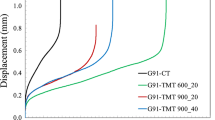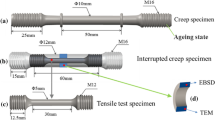Abstract
The term “long-term creep properties” for heat resistant steels is mainly reflected by the 100.000 hour creep rupture strength at elevated testing temperature. Often, results of high stress, short-term creep tests are extrapolated to this 100.000 hour target value. Results of long-term creep tests are rather rare because of high testing costs and the time consuming testing procedure. Especially, long-running crossweld creep tests have not been performed in a sufficient extent so far, although, the heat-affected zone of crosswelds of ferritic chromium steels is known as a possible weak point. The long-term creep properties of crosswelds is linked to microstructure of the heat-affected zone of 9–12% chromium steels. The formation of heat-affected zone microstructures is studied by dilatometry, in-situ X-ray diffraction using synchrotron radiation, optical microscopy as well as most advanced electron microscopic methods. Results of crossweld creep tests up to duration of 40,000 hours are directly linked to the heat-affected zone microstructure at the location of fracture. The most predominant failure mechanism at lower stress levels and long term duration is Type IV cracking in the fine-grained heat-affected zone region of crosswelds. The failure mechanism is discussed in detail in this paper.
Similar content being viewed by others
References
Scarlin B, Kern T U and Staubli M, The European efforts in material development for 650°C USC power plants — COST522, Proc. 4 th International Conference on Advanced Materials Technology for Fossil Power Plants, Liege, (2004).
Albert S K et al: Microstructural investigations on Type IV cracking in a high Cr steel, ISIJ International, 42(12) (2002) 1497.
Masuyama F, Komai N and Sasada A, Creep failure experience in welds of advanced steel boiler components, IIW Doc. XI-795-04, 2004.
Tezuka H and Sakurai T, A trigger to Type IV damage and a new heat treatment procedure to suppress it. Microstructural investigations of long-term ex-service Cr-Mo steel pipe elbows. International Journal of Pressure Vessels and Piping, 82 (2005) 165.
Tabuchi M, and Takahashi Y, Evaluation of creep strength reduction factors for welded joints of modified 9Cr-1Mo steel (P91), 2006 ASME Pressure Vessels and Piping Division Conference, Vancouver, ASME, (2006).
Schüller H J, Hagn L and Woitscheck A, Risse im Schweißnahtbereich von Formstücken aus Heißdampfleitungen — Werkstoffuntersuchungen, Der Maschinenschaden, 47(1) (1974) 1.
Mayr P, “Evolution of microstructure and mechanical properties of the HAZ in boron containing 9% Cr steels”, PhD Thesis, Graz University of Technology, (2007).
Mayr P, Palmer T A, Elmer J W and Specht E D, “Direct observation of phase transformations in the simulated heataffected zone of a 9Cr martensitic steel”, Int. J. Mat. Res., 99 (2008) 381.
Mayr P, Jochum C, Pasternak J and Cerjak H, Long-term creep behavior of E911 heat resistant 9% Cr steel weldments fabricated with filler metals of different creep strength, Proceedings of CREEP 8, PVP2007-26713, ASME, (2007).
Creep Data Sheet E911, Creep Collaborative Committee, (2005).
Middleton C J, Metcalfe E, A review of laboratory Type IV cracking data in high chromium ferritic steels, Proceedings of Steam Plants for the 1990’s, London, IMechE, (1990).
Ellis F V and Viswanathan R, Review of Type IV cracking in piping welds, Proceedings of Integrity of High Temperature Welds, London, IOM, (1998).
Francis J A, Mazur W and Bhadeshia, H K D H, Type IV cracking in ferritic power plant steels, Mater Sci Techno, 22(12) (2006) 1387.
Kondo M et al, Suppressing type IV failure via modification of heat affected zone microstructures using high boron content in 9Cr heat resistant steel welded joints, Science and Technology of Welding and Joining, 11(2) (2006) 216.
Albert S K, Kondo M, Tabuchi M, Yin F, Sawada K and Abe F, Improving the creep properties of 9Cr-3W-3Co-NbV steels and their weld joints by the addition of boron, Metallurgical and Materials Transactions A, 36A (2005) 333.
Author information
Authors and Affiliations
Corresponding author
Rights and permissions
About this article
Cite this article
Mayr, P., Cerjak, H. The impact of welding on the creep properties of advanced 9–12% Cr steels. Trans Indian Inst Met 63, 131–136 (2010). https://doi.org/10.1007/s12666-010-0018-9
Received:
Revised:
Accepted:
Published:
Issue Date:
DOI: https://doi.org/10.1007/s12666-010-0018-9




